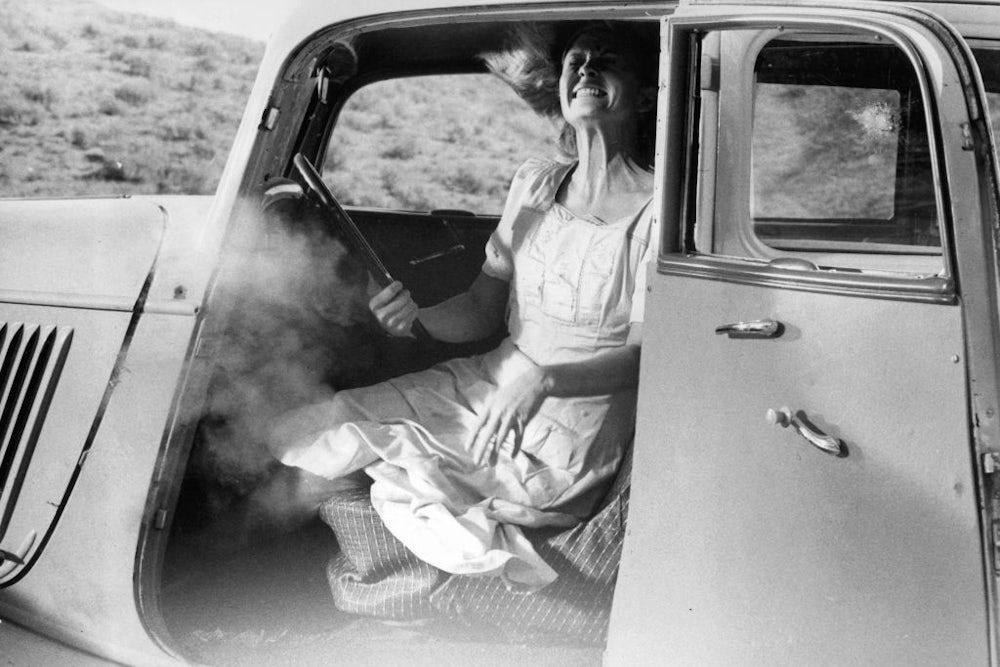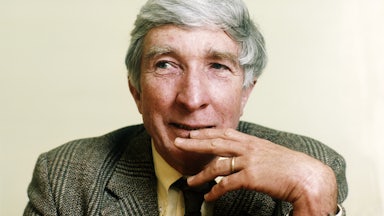About 20 years ago, a neuroscientist named David Eagleman strapped a bunch of students into harnesses, hoisted them to the top of an imposing metal tower, and then, without warning, dropped them 150 feet. Though the students landed safely in nets, the experience was—by design—terrifying. Eagleton wanted to simulate the feeling of plummeting to one’s death. His goal was to figure out why survivors of near-death experiences almost always said the same thing: “It felt like the world was going in slow motion.”
Ultimately, Eagleman concluded that perception does not actually slow down when we crash our car or fall out of a tree. Instead, our brains—realizing this moment is important—retain much more detail: what we see, feel, think. The “slow-mo effect,” in other words, is retrospective, a trick of memory. Still, it indicates a remarkable theatricality, a cinematic flair, on the part of our brains. “We might experience almost everything in some form of slow motion if we thought that we were always dying,” the cultural scholar Mark Goble writes of Eagleman’s conclusion. “Which we are, of course, but not fast enough to matter to our brains.”

Slow motion is, today, the most popular special effect in film and television—a designation that leads Goble to label it, in his mesmerizing new book, Downtime: The Twentieth Century in Slow Motion, “the very least special effect.” On screen, it has become so common as to be barely noticeable; it serves to ratchet up suspense, emphasize a meaningful moment, or reveal a reality viewers might otherwise miss. Most famous, perhaps, is the slow-moving bullet from The Matrix, but other iconic moments include the train station shoot-out from The Untouchables, the title sequences from Reservoir Dogs (men walking) and Chariots of Fire (men running), and, in a million permutations, the Zapruder film. Stylistically, the Marvel and D.C. cinematic universes seem to consist of little else but slo-mo, with a full 10 percent of Zach Snyder’s cut of the Justice League proceeding at a reduced speed.
Yet slow motion is no longer confined just to the silver screen. In the broader culture, it has become part of the stock vocabulary of trauma. Not only survivors of vertiginous falls but also drug users, victims of violent attacks, individuals pushed to their physical limits, even those who witnessed 9/11—all have invoked the feeling of seeing, or sensing, in slo-mo. This technique of filmmaking, in other words, has given us a new way of articulating—perhaps even perceiving—the world around us.
Slow motion, Goble argues, is the perfect effect for our imperfect age. It captures “time as we experience it in the modern world: variously uneven, punctuated and accelerated, dragging and expanding, beautiful, traumatic, endless, and commodified.” Since the industrial revolution, some observers have suggested that history seems to be accelerating. (“Time has now become so fluidly rapid,” one German novelist wrote to her friend in 1809. “It is not possible to keep up; between one mail day and the other lies an entire historical epoch.”) But, in Goble’s telling, the speed of events seemed to achieve a new momentum in the late ’60s, when in a matter of months, slo-mo suddenly transformed from a “minor” aesthetic approach present in a handful of commercial films to the dominant, omnipresent special effect of the next half-century.
Today, as history hurtles forward, it’s unsurprising that slow motion retains its popularity. If, as Goble suggests, we might experience “everything” in slow motion if we always thought we were dying, perhaps it’s telling that so many are experiencing everything in a kind of slow motion, a feeling of “stuckness,” a sense that our political moment has become both endless and inescapable.
“The history of film might well begin in slow motion,” Goble writes early in Downtime. In Hollywood’s first days—before the widespread introduction of the motorized camera and electrical projector in the early 1910s—movies had to be “cranked” by hand, meaning that any operator cranking slower than the intended frame rate was, technically, creating or showing a movie in slo-mo.
Yet even in the nineteenth century, some filmmakers were deliberately manipulating time by “overcranking” the camera and then showing the film at “normal” speed. Goble points to an 1897 film of a boxing match (the Corbett-Fitzsimmons Fight), which included a slow-motion “replay” of the knockout blow, as well as a racist 1901 short called The Indian Chief and the Seidlitz Powder, as early examples of this technique.
It was at precisely this time, the turn of the century, that filmmakers were developing the earliest camera techniques—close-ups, “shot-reverse-shot editing,” etc.—which today feel essentially inherent to the very enterprise of cinema. Yet slow motion was “vanishingly rare,” Goble writes, until the 1920s, when a number of directors—especially those making educational and sports films in which deliberate deceleration might be revealing—apparently found it suitable (or easier to achieve on more technologically sophisticated cameras). Indeed, for most of the next half-century, the “vast majority” of slo-mo appeared in newsreels featuring athletics (running, dancing, etc.) or instruction (stitch up the patient like so), rather than the increasingly prestigious fare of the movie palace.
The first American feature film that Goble has found to be using slow motion is the silent-era classic The Thief of Bagdad (1924), in which Douglas Fairbanks fends off a massive underwater spider with unnaturally unhurried grace. The first slo-mo explosion that he has encountered in a feature film is in Three Songs About Lenin (1934), by the great Soviet auteur Dziga Vertov. But Goble cautions against looking for any true “first,” noting the sheer quantity of early films that do not survive in watchable form. With “years” of effort, he has tracked down “sixty or so appearances of slow motion” before the 1960s—but the available archive from which he’s drawing represents a pitiful fraction of what once played in theaters across the country.
“What is remarkable,” Goble writes, “is the slowness of slow motion’s growth over the decades, given that it was technologically possible from the first moments of film’s development.” Indeed, as Hollywood entered and eventually exited its “Golden Age,” slo-mo remained a relative rarity, a trivial, “often pretty tasteless” technique.
There are, of course, standout exceptions. Olympia (1938), Leni Riefenstahl’s four-hour documentary of the Nazi-hosted 1936 Summer Olympics, is replete with monumental decelerations; Akira Kurosawa made use of the effect throughout his career, from his 1943 debut, Sanshiro Sugata, through his epic Seven Samurai (released in Japan in 1954). Yet these remain the exception rather than the rule. (Indeed, Seven Samurai is the only film released in the United States in 1956 to use slow-mo, at least so far as Goble can tell.) Where slow motion did appear, it usually served to emphasize human bodies and what violence could do to them. But filmmakers before the ’60s generally turned to other effects to achieve a visceral blow to the gut.
Then, abruptly, everything changed. On August 4, 1967, Bonnie and Clyde premiered at the Montreal Film Festival. It was a pathbreaking movie in many respects, but most important to Goble is its memorably bloody last scene, with its two antiheroes lurching in painfully slow motion as countless bullets enter their bodies. The scene, instantly iconic, “must count among the most cited, imitated, and influential sequences in American film,” Goble writes.
Yet while Bonnie and Clyde may fairly be credited with kicking off the modern explosion of slow motion, it certainly did not do so alone. Indeed, director Arthur Penn acknowledged drawing inspiration from Seven Samurai for the slo-mo in his final tableau; according to one account, Kurosawa’s masterpiece also inspired the slow-motion instant replays of sports highlights that were multiplying across TV stations in the ’60s.
Less than a year after Bonnie and Clyde came Stanley Kubrick’s 2001: A Space Odyssey, a film that instantly became as famous for its opening scene as Bonnie and Clyde did for its closing. Amid an orchestral swell, a prehistoric hominid encounters an alien monolith and, surrounded by animal bones, suddenly learns how to use them as weapons. Lifting a bone to the sky, the hominid brings it down in grand slow-mo. The scene is remarkable, Goble opines, not merely for its undeniable flair, but also because “every prior instance of slow motion” placed the focus on the body or object being acted upon. “What we see here, quite possibly for the first time in film history, is violence in slow motion from a perspective that aligns entirely with the figure causing it to happen instead of feeling its effects.”
With both of these movies in theaters, slow motion had achieved what Goble calls “escape velocity.” The year 1968, he writes, was the “annus mirabilis” for the special effect, closing with Sergio Leone’s Once Upon a Time in the West, another vehicle for iconic slow-mo. A few months later followed Sam Peckinpah’s The Wild Bunch (a bravura exemplar of slowed-down violence), and then, in 1970, Michelangelo Antonioni’s Zabriskie Point, which featured not merely the biggest Hollywood explosion to date but also a slo-mo orgy in the desert.
Why was slow motion suddenly everywhere as the ’60s came to an end? The answer, at least according to Goble, lies in the unique confluence of crises that came to a head as the promise and possibility of “the sixties” foundered at the pointy ends of bayonets. History, once again, was speeding up. It’s no surprise, then, that 1968, slow-mo’s annus mirabilis, has itself become a shorthand for political turbulence. Slow motion, à la Goble, gave filmmakers and their audiences “the time it takes to appreciate the complexity and sheer extent of the machines and systems and economies that have captured us.” It’s an unprovable argument, but a believable conclusion.
After 1970 or so, the use of slow motion expanded so quickly and so widely that it became effectively impossible to track in an authoritative way. Probably for this reason, Goble devotes little space to the last 50 years—which is a shame, as he’s a wry and witty critic. He does note that the use of slo-mo accelerated sharply as “blockbuster cinema” dominated the 1970s and ’80s, and then again with the increasing availability and sophistication of computer-generated imagery in the 2000s. A few years later, you and I and everyone were empowered to make our own slow-motion videos by the introduction of “speed ramping” and “time remapping” in Adobe Premiere Pro and then on smartphones, starting with the Samsung i8000 Omnia II (2009) and iPhone 5S (2013).
Today, there is an effectively infinite amount of slo-mo across YouTube, TikTok, and countless screens and streamers. (Also, porn! Lamentably, Goble gives little critical attention to the use of slo-mo in pornography.) And all this is to say nothing of the “who knows how many megabytes of video shot on our phones and stored away on hard drives,” Goble adds, “an anonymous archive of media that shows levels of technological proficiency that, for most of the twentieth century, only the most accomplished filmmakers could have achieved.”
Our world is, obviously, ending. Oceans and carbon dioxide levels are rising with alarming, historically unprecedented swiftness; whole ecosystems are collapsing; authoritarian regimes are seizing power across the globe; borders are hardening; alienation and isolation have become commonplace; future pandemics beckon. Amid this jarring hurtle toward the abyss, slow motion has become not merely ubiquitous on screen but also a shorthand to express, or even a lens to view, our reality. “Slow motion,” writes Goble, “is what modernity looks like as it is dying.”
In a slightly surprising move, he devotes a solid chunk of Downtime to analyzing the use of slow motion as a tool of the novelist, citing the work of such literary icons as William Faulkner, Don DeLillo, and W.G. Sebald. For these and many others, the deployment of slow motion on the page—elongating certain moments, dwelling at unnatural length on certain events—became a significant device they used to depict modern life.
DeLillo, for instance, described the first plane hitting the World Trade Center in his novel Falling Man at a tortuous, distorted pace, his protagonist becoming “aware of vast movement and other things, smaller, unseen, objects drifting and skidding, and sounds that weren’t one thing or another but only sound, a shift in the basic arrangement of parts and elements.” Noting the similarity of this depiction to scenes of slow motion from The Matrix and Inception, Goble writes: “I am not suggesting that DeLillo has this in mind when he enlists slow motion at a crucial moment of dilated time in Falling Man but rather that its appearance is all but reflexive. It makes perfect sense to us that history happens now as acceleration and deceleration at the same time.”
If there is any hope to be found in Downtime, it is in the unpredictability that accompanies the relentless march of time. “I didn’t write this book fast enough for my parents to get to see it,” Goble notes. “But I took long enough that now my daughter won’t have to wait to read it.” I welcomed my own two sons in the last year. The days drag and race by. This isn’t the world I would’ve wished for them, but it’s one I will fight to make better until they’re big enough to join in the struggle.










